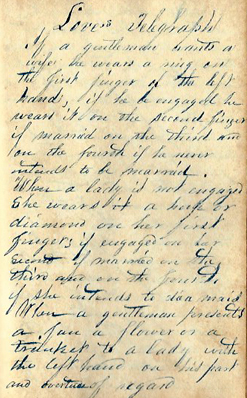
In the pocket notebook of William Henry Gough (1826-1910) were many of the things that occupied the mind of a young man: money matters, his lessons at Mt. Merino Seminary in Breckinridge County, Kentucky, and later his duties as a surveyor and sheriff of Meade County. But given its intricacies, he also devoted two pages to the workings of “Love’s Telegraph,” the rules regarding transmission of one’s intentions in matters of courtship and romance. Most valuable was the way one could avoid any need to explain oneself in words–those awkward stammerings, repeated entreaties, apologies, and other messy emotional declarations that go with the business of finding (or avoiding) a potential mate. Here was the tutorial:
If a gentleman wants a wife he wears a ring on the first finger of the left hand, if he be engaged he wears it on the second finger, if married on the third and on the fourth if he never intends to be married.
When a lady is not engaged she wears a hoop or diamond on her first finger; if engaged on her second, if married on the third and on the fourth if she intends to die a maid.
When a gentleman presents a fan a flower or a trinket to a lady with the left hand on his part and overtures of regard should she receive it with the left hand it is considered as an acceptance of his esteem but if with the right it is considered as a refusal of the offer.
Thus by a few simple tokens explained by rule the passions of love are expressed and through the medium of the Telegraph the most timid and diffident man may without difficulty communicate his sentiments of regard for a lady and in case his offer should be refused avoid expressing the mortification of explicit refusal.
William H. Gough’s notebook is part of the Manuscripts & Folklife Archives of WKU’s Department of Library Special Collections. Click here for a finding aid. For more collections, search TopSCHOLAR and KenCat.
